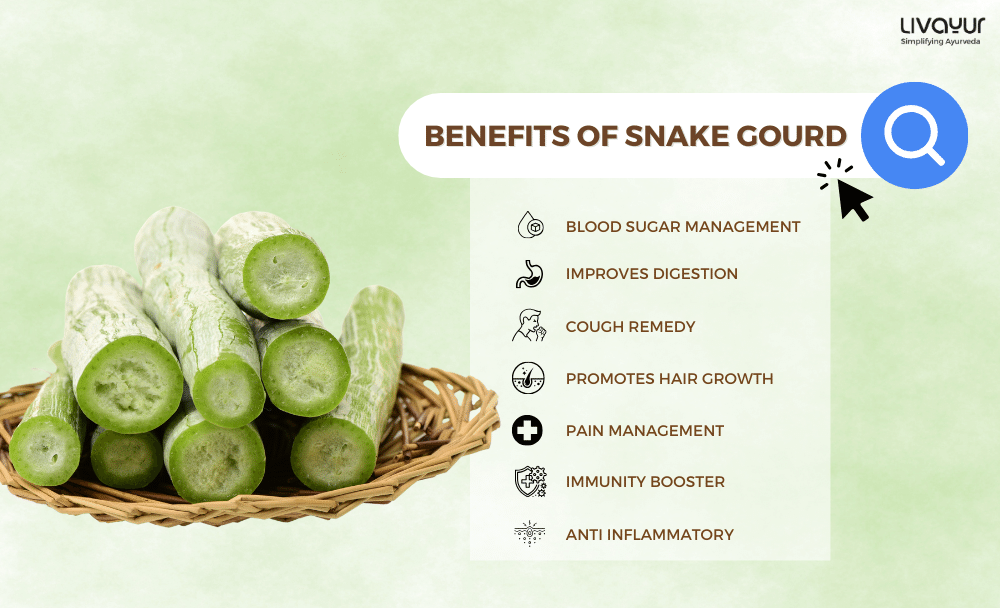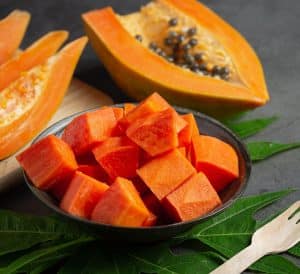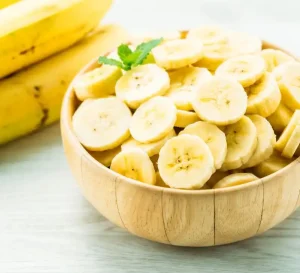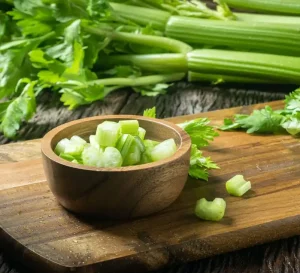
The snake gourd, also known as Trichosanthes cucumber or Chinese cucumber, is consumed as a vegetable for its highly nutritious properties. The snake gourd owes its name to its appearance which is a long, thin, cylindrical shape with a slightly curved end, imitating the shape of a snake. It is commonly used in Asian cuisine. It is known by many other names such as snake tomato, viper gourd, long tomato, etc.[6]
While low in calories, it is a very rich source of functional constituents apart from its basic nutrients, such as carotenoids, phenolic acids, flavonoids, and soluble and insoluble dietary fibers.
Apart from these, the snake gourd offers some essential minerals that make the plant very active, both pharmacologically and therapeutically.
In other words, this vegetable contains proteins, high levels of vitamins A and E, minerals, and fiber, which make it an excellent addition to any healthy diet. [1]
The snake gourd’s benefits have been gauged since ancient times, making it a valuable addition to medicinal sciences like Ayurveda. The vegetable has since been used in the treatment of various ailments.
Some of them are headache, alopecia, bilious, boils, acute colic diarrhea, fever, abdominal tumors, haematuria, and skin allergy. [1]
In this article, we will delve deep into the nutritional value and snake gourd benefits for health along with its uses and potential side effects.
Nutritional properties of snake gourd
| Nutrient | Amount |
|---|---|
| Calories | 17 kcal |
| Water | 95.6 g |
| Protein | 0.6 g |
| Carbohydrates | 3.9 g |
| Fiber | 0.6 g |
| Sugars | 2.2 g |
| Fat | 0.2 g |
| Vitamin C | 8.4 mg |
| Vitamin A | 25 IU |
| Calcium | 20 mg |
| Iron | 0.4 mg |
| Magnesium | 16 mg |
| Phosphorus | 24 mg |
| Potassium | 43 mg |
| Sodium | 1 mg |
| Zinc | 0.3 mg |
| Manganese | 0.142 mg |
Snake gourd is enriched with nutrients, vitamins, and minerals that are extremely helpful for human health.
Pharmacological properties
The snake gourd owes its pharmacological properties to the presence of phytochemicals such as alkaloids, flavonoids, glycosides, tannins, and steroids. [2]
1. Antioxidative properties
This helps protect the body from free radical damage in cell structures, lipids, proteins, nucleic acids, and other body components. All these, in turn, cut down the risk and progression of many acute and chronic diseases like cancer, diabetes, cardiovascular diseases, and other metabolic syndromes. It has also been found that all parts of the plant, including the snake gourd vegetable and the snake gourd seeds, have antioxidative properties. [2]
2. Dietary minerals
These elements are present in a snake gourd in both soluble and insoluble forms and help carry out a vast range of functions, such as regulating the body’s pH, building bones and cell structures, carrying charge, and driving chemical reactions. They also help improve digestion, prevent diseases, and take care of the overall health of an individual. [2]
Snake gourd benefits
Studies suggest that the snake gourd health benefits are immense, and incorporating a snake gourd recipe in a daily platter can let you ward off various ailments.
1. Keeps blood sugar levels in check
The snake gourd vegetable is believed to possess anti-diabetic potential. It can also amp up the glucose tolerance level of the body by virtue of absorption into the surrounding tissues, thus keeping blood sugar in control.[3]
2. Improves digestion
The fiber content in snake gourd helps to regulate digestion, improve metabolism, and prevent constipation. Extract from the snake gourd vegetable can be incorporated into a snake gourd recipe to help enhance the protective mucous layer of the stomach. It also hinders activities that damage stomach cells, especially from substances like such as ethanol and indomethacin. [4]
3. Is effective against cancer cells
Studies have shown that snake gourd benefits also include an effect against various kinds of cancer. [6] They have also been seen to have potent antioxidant and anti-inflammatory properties.
4. Is an effective cough remedy
Snake Gourd can treat cough and cold [8] by keeping your airways and respiratory tract free from phlegm. A bowl of piping hot snake gourd soup can soothe your sinuses and airways.
Want to know what fruits to eat and avoid in a cough? Read our related article on – Best Fruits to Eat and Avoid During Cough and Cold
5. Promotes hair growth
Being rich in carotene, the vegetable can support healthy hair growth and strengthening of hair at the roots. [8]
6. Manages pain
Snake gourd can be used to manage aches and pains due to its anti-inflammatory properties. [2]
7. Boosts immunity
The rich nutritional profile of this vegetable strengthens your immune system. Phenolic acids, flavonoids, minerals like zinc, phosphorus, sodium, potassium, and magnesium, and vitamins like A, and E [2] present in this veggie fuel the smooth functioning of your immune system.
8. Detoxifies your system
Toxic substances may easily be removed from your body with the use of snake gourd. This vegetable acts as a powerful diuretic. Different impurities can be removed from your body if you consume snake gourd.
9. Relieves constipation
Snake gourd is a mild laxative and is loaded with fiber, which can support easy bowel movements. Therefore, consumption of snake gourd can help you with constipation issues. [7]
10. Strengthens your teeth and bones
Calcium in this vegetable can strengthen your teeth and bones. Snake gourd is an effective way to keep issues like osteoporosis at bay.
Snake gourd uses
Snake gourd is used mainly as a vegetable in Asian households. Even the snake gourd seeds can be consumed after cooking. One can stir-fry it and use it in curries, chutneys, and soups. The various recipes made out of snake gourd taste great with rotis, chapattis, and rice too. Also, when ripe, the snake gourd may be used as a food coloring agent. [8]
How to consume snake gourd
Snake gourd may be consumed in various ways:
- Salads: You may consume snake gourd as a raw vegetable in a salad. You may mix other vegetables like capsicum, and tomato in this salad. Adding a dash of ginger powder, black salt, and roasted mustard seeds to this salad may make it taste really great.
- Cooked: Snake gourd may be cooked as a vegetable. You may add it to your curries, or soups, or simply stir-fry it. The snake gourd taste and texture improve a lot when it is stir-fried.
- Tomato substitute: When the snake gourds are ripened fully, they may have a reddish tomato-like pulp which may be used as a tomato substitute in sauces, pickles, and curries.
- Juiced: Snake gourd may be consumed as a fresh green juice. There has been an increasing craze for green juices in recent times. Most health-conscious people love to take green juices. Drinking snake gourd juice every morning is definitely a healthy way to start the day!
Side effects of snake gourd
Although snake gourd is generally considered safe to eat and rarely exhibits any allergic reaction, sometimes a snake gourd recipe may turn out to be bitter due to terpenoid toxic compounds such as cucurbitacin B, D, G, and H, among others. If you feel any discomfort after its consumption, such as nausea, vomiting, diarrhea, or any feeling of uneasiness, medical attention must be sought. [5]
FAQs
1. Can snake gourd juice be taken daily?
Yes, snake gourd juice may be taken daily by people who are looking forward to losing weight. Being extremely low in calories, the snake gourd juice can definitely be a part of your strict diet regimen.
2. Are there any snake gourd benefits for the liver?
Yes, there are potential snake gourd benefits for the liver, and in ancient times it was also used as a medicine for the same purpose. The ethanol extract from the snake gourd vegetable protects the liver from carbon tetrachloride-induced hepatotoxicity.
3. Can snake gourd taste bitter?
Yes, sometimes mature snake gourds may taste bitter. As they become mature, they become tougher and their flesh becomes bitter.
4. What are some of the local names of snake gourd?
Snake gourd is known by several local names like Chichinga in Bengali, Potlakaaya in Telugu, Padavalanga in Malayalam, and Pudalankaal in Tamil.
5. Can snake gourds be given to kids?
Yes, snake gourds can be given to children. It is high in nutrients and fiber. Several interesting recipes may be prepared using snake gourds. You may stuff snake gourds in your child’s sandwiches or paranthas.
Conclusion
Snake gourd is a nutritious and delicious vegetable that can be highly beneficial for health when consumed in moderation. It is a low-calorie food with high fiber content that can help with weight loss, digestion, and other health-related issues. In the present article, we got to know about the multiple snake gourd properties and snake gourd benefits. So, next time you go to your local vegetable market, don’t forget to pick snake gourds.
Disclaimer:
This article is written from a health and wellness perspective and is not medical advice. So, please see a doctor before starting a snake gourd-based treatment.
References:
- Comparative Analysis of Nutritional and Bioactive Properties of Aerial Parts of Snake Gourd (Trichosanthes cucumerina Linn.)
- Comparative Analysis of Nutritional and Bioactive Properties of Aerial Parts of Snake Gourd (Trichosanthes cucumerina Linn.)
- Chapter 4 – Beneficial effects of gourds on health and diseases
- Chapter 13 – Promising Functional Lipids for Therapeutic Applications
- Snake Gourd: A Review of its Nutritional and Medicinal Efficacy
- AN UPDATED REVIEW ON TRICOSANTHES CUCUMERINA L
- Medicinal Values of Trichosanthes cucumerina L
- Medicinal Values of Trichosanthus cucumerina L. (Snake Gourd) – A Review
























